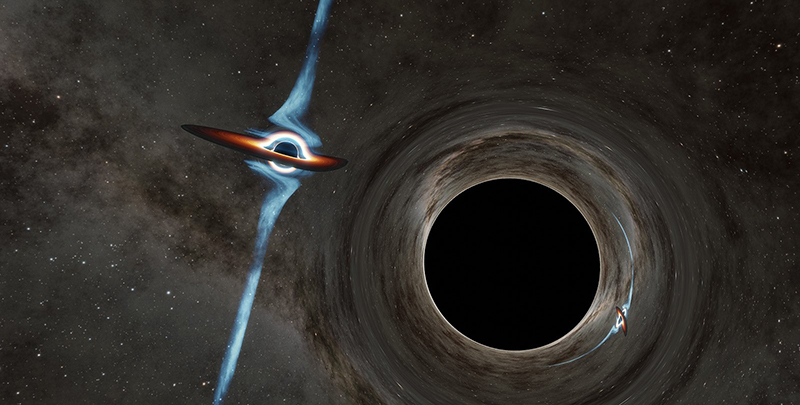互いの軌道を回る2つのブラックホールは、やがて合体する (Two black holes orbiting one another eventually will merge)
2022-03-11 パデュー大学

2つの超巨大ブラックホールが互いの軌道を回る連星系。他の唯一の超巨大ブラックホール連星系のブラックホールよりも10倍近い距離で互いに接近している. (Caltech/R. Hurt, (IPAC))
<関連情報>
- https://www.purdue.edu/newsroom/releases/2022/Q1/scientists-announce-discovery-of-supermassive-binary-black-holes-two-black-holes-orbiting-one-another-eventually-will-merge.html
- https://iopscience.iop.org/article/10.3847/2041-8213/ac504b?_ga=2.265559820.2073862835.1647733990-1821154232.1645755642
ブレイザーPKS 2131-021の予期せぬ現象。ユニークな超巨大ブラックホール連星候補天体 The Unanticipated Phenomenology of the Blazar PKS 2131–021: A Unique Supermassive Black Hole Binary Candidate
S. O’Neill, S. Kiehlmann, A. C. S. Readhead, M. F. Aller, R. D. Blandford, I. Liodakis, M. L. Lister, P. Mróz, C. P. O’Dea, T. J. Pearson V. Ravi, M. Vallisneri, K. A. Cleary, M. J. Graham, K. J. B. Grainge, M. W. Hodges, T. Hovatta6, A. Lähteenmäki, J. W. Lamb, T. J. W. Lazio, W. Max-Moerbeck, V. Pavlidou, T. A. Prince, R. A. Reeves, M. Tornikoski, P. Vergara de la Parra, and J. A. Zensus
Published 2022 February 23 • © 2022. The Author(s). Published by the American Astronomical Society.
, , Citation S. O’Neill et al 2022 ApJL 926 L35
Abstract
Most large galaxies host supermassive black holes in their nuclei and are subject to mergers, which can produce a supermassive black hole binary (SMBHB), and hence periodic signatures due to orbital motion. We report unique periodic radio flux density variations in the blazar PKS 2131−021, which strongly suggest an SMBHB with an orbital separation of ∼0.001–0.01 pc. Our 45.1 yr radio light curve shows two epochs of strong sinusoidal variation with the same period and phase to within ≲2% and ∼10%, respectively, straddling a 20 yr period when this variation was absent. Our simulated light curves accurately reproduce the “red noise” of this object, and Lomb–Scargle, weighted wavelet Z-transform and least-squares sine-wave analyses demonstrate conclusively, at the 4.6σ significance level, that the periodicity in this object is not due to random fluctuations in flux density. The observed period translates to 2.082 ± 0.003 yr in the rest frame at the z = 1.285 redshift of PKS 2131−021. The periodic variation in PKS 2131−021 is remarkably sinusoidal. We present a model in which orbital motion, combined with the strong Doppler boosting of the approaching relativistic jet, produces a sine-wave modulation in the flux density that easily fits the observations. Given the rapidly developing field of gravitational-wave experiments with pulsar timing arrays, closer counterparts to PKS 2131−021 and searches using the techniques we have developed are strongly motivated. These results constitute a compelling demonstration that the phenomenology, not the theory, must provide the lead in this field.



